How loopwheel sweatshirt fabric is made – at Aigat, Wakayama
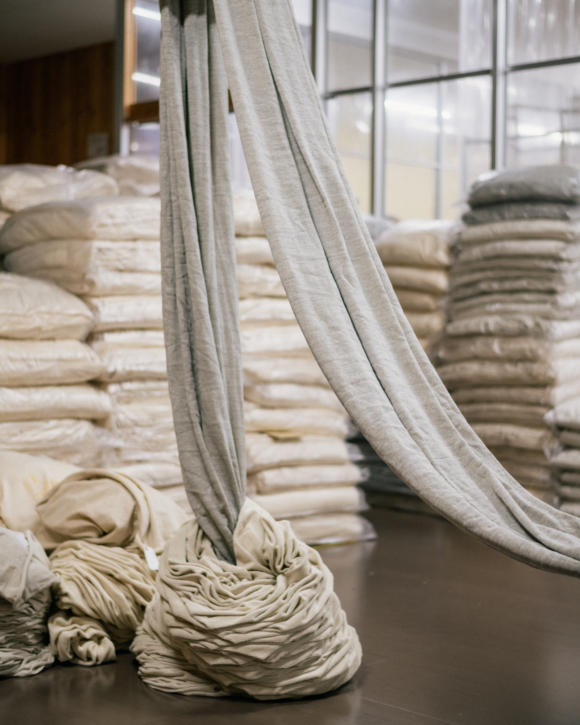
In the corner of the Aigat mill in Wakayama, there are a few knitting machines that look like none of the others - monsters, hybrids.
The rest of the mill is split in two, with the more modern ‘sinker’ machines (below) in one half, wooden-beamed loopwheels (above) in the other.
But in the corner, the owner is trying to fuse them together. “This first one is a loopwheel, but I’ve hooked it up to an electronic system to try and make it do jacquard knitting. It’s kind of, sort of working,” he says.
The second is a sinker, but it’s being run as slow as possible. “Slower than you’re meant to, just to see its limits,” he explains. The main reason loopwheel machines are so valued is that they knit slowly (one metre an hour) which makes the fabric air-filled and soft.
“It would be great if we could get a sinker to do almost the same, because the loopwheel machines are hardly being made any more - you have to salvage them, even just to get parts to keep these ones going.”
The problems are the same, it turns out, whether you’re making sweaters in Scotland, shoes in England or French terry in the hills of Japan. The demand for quality clothing is shrinking, and no one is making the machines that make the fabric that makes the clothes.
It was probably inevitable, given those dynamics. You travel halfway around the world, drive two hours into the forested hills, and find somewhere that feels rather like a British flannel mill.
The reception is the same, with its samples and swatches. The roar of the machines is the same, the workers walking between them, checking one, tweaking another. Even the owner feels familiar: a 70-year-old enthusiast who’s constantly tinkering, and his son-in-law that runs a lot of the development (above, left and right).
Our visit to Aigat, kindly arranged by the team at The Real McCoy’s, made me feel many things, including this sense of familiarity.
But the strongest emotion was probably one of protection. It’s easy to feel that French terry, used for making sweatshirts and jogging bottoms, is a ubiquitous material that has nothing in common with a Scot hand-weaving tweed in a shed.
But at the top end, the real quality stuff is just as crafted and precarious. Very few places in the world still make loopwheel, the other major one being Merz b Schwanen in Germany, and the pandemic caused many of these small producers to close. Japan has the largest concentration of them in the world and even it's suffering.
It really makes me value my sweatshirts, sitting folded in a cupboard half a world away.
OK so enough of the evangelising - how is loopwheel fabric made?
Well, it’s a circular knitting machine, unlike the flat-bed machines we’ve covered at places like Loro Piana. The machine is actually like a huge sock knitter - at least that was my connection, having seen them at sock brands like Bresciani and Mes Chaussettes Rouges.
Yarn is fed from the top, in a halo around the the ranks of needles. The knitting takes place inside, so you can’t see much of what’s going on. But then out of the bottom comes a long satisfying cylinder of fabric, a bit like a massive snood.
The sinker part of the factory is also encased in plastic sheeting, to prevent one colour corrupting another.
This gives it a slightly spooky feel, particularly when you catch something moving out of the corner of your eye, cloaked by multiple layers of sheeting. People become amorphous, ghost-like. It would actually be a good setting for a spy movie, with the goodie stalking the baddie through the layers of plastic.
The loopwheel side of the factory is prettier, primarily old steel and wood. These machines are around 100 years old – the sinker ones merely 70 or 80.
One axle runs the length of the room, powered by a little motor, which then everything runs off. So all the machines have to go the same speed all the time.
My favourite part, however, is the jars of homemade lubricator (below). These have lengths of fabric in them, which are then tied around the rod above. The yarn runs across this as it goes into the machine, becoming coated with the lubricator.
Oh and one other thing - the loopwheel machines have to be cleaned frequently, with a wooden pole that takes off excess fluff. The worker has to curl the fluff around the end, with exactly the same gesture as scooping candy floss out of a candy floss maker.
Aigat is a fairly small operation, but the only one in Japan that has both types of knitting machine in one place, which makes it fertile ground for experimentation and making those hybrids.
The prefecture itself, Wakayama, is where most knitting in Japan is concentrated, and is green and mountainous – something else in common with craft elsewhere in the world, as mountain water is often prized for washing, eg around Biella in Italy.
Visiting Aigat gave me a lot of respect for them, but also for the brands working with them. Volumes are small, the wait times long, it would be so much easier to use a larger, modern manufacturer. But as the poster on the wall says, that wouldn’t be ‘slow vintage’.


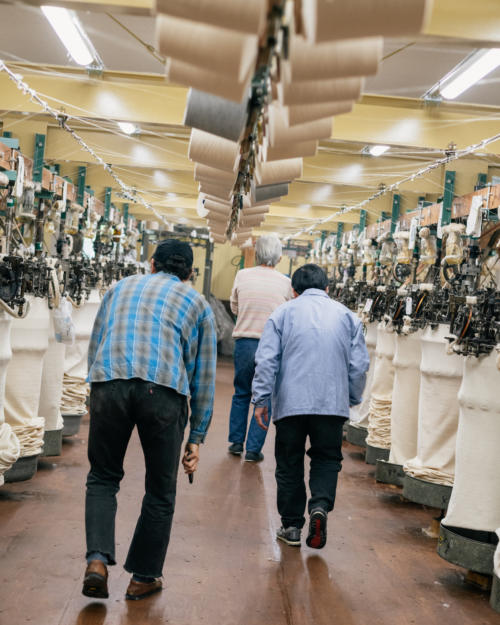
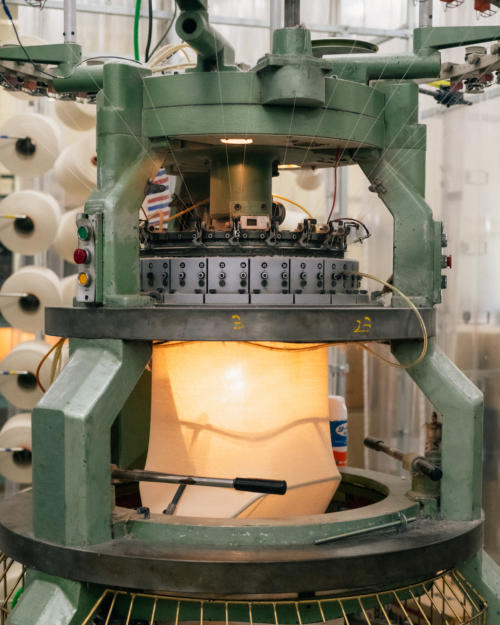
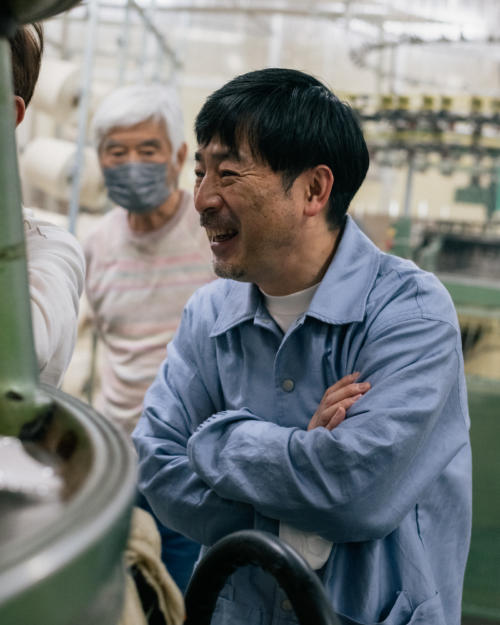
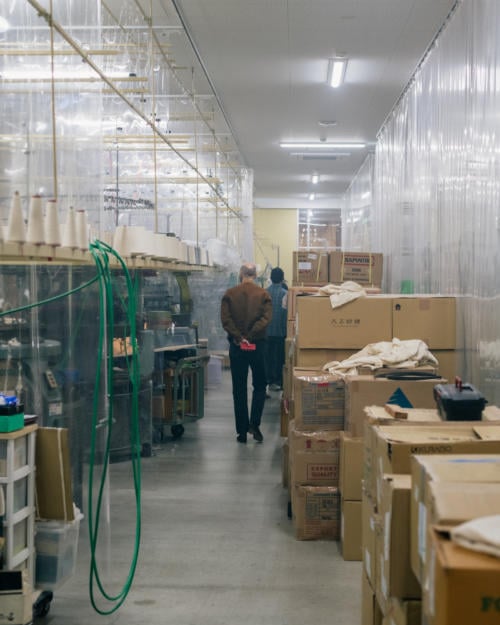
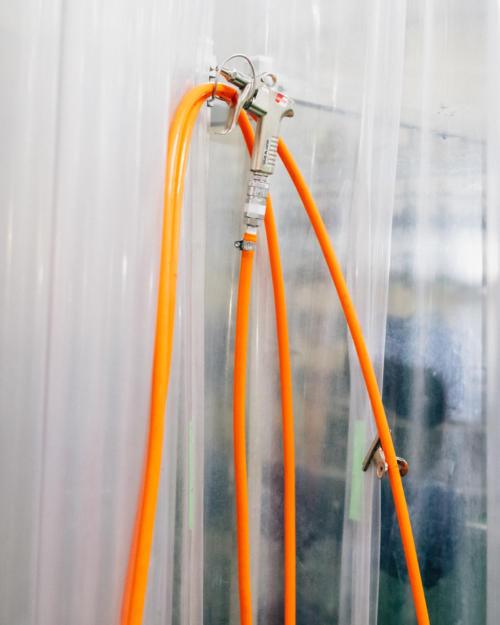
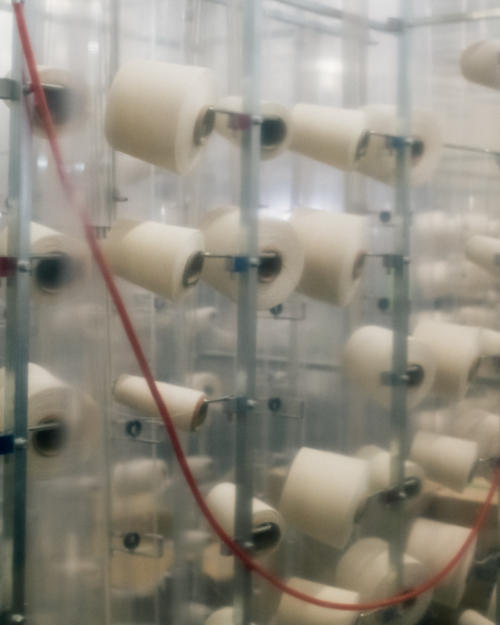
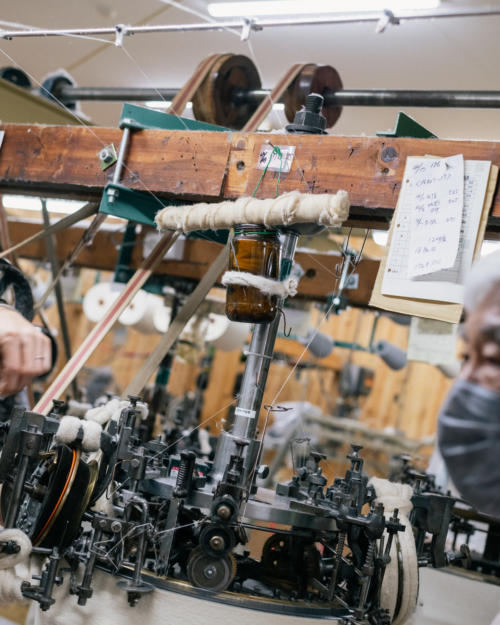
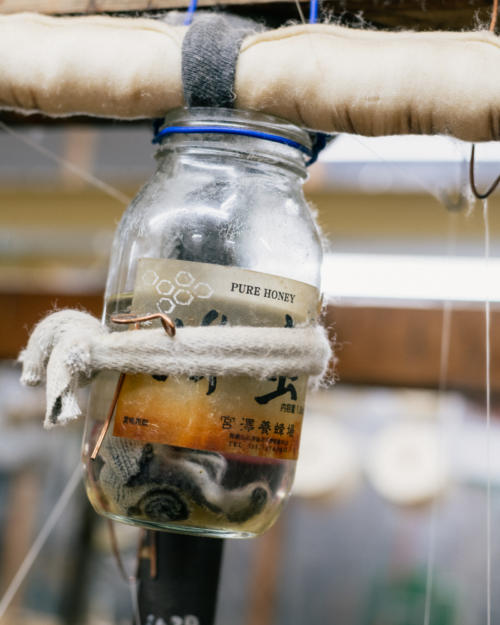
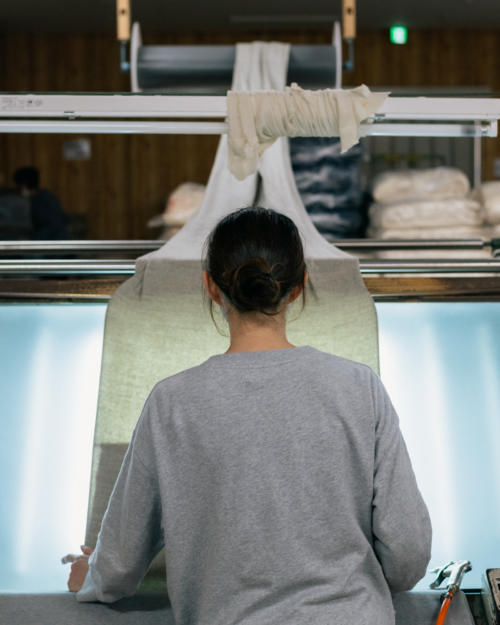
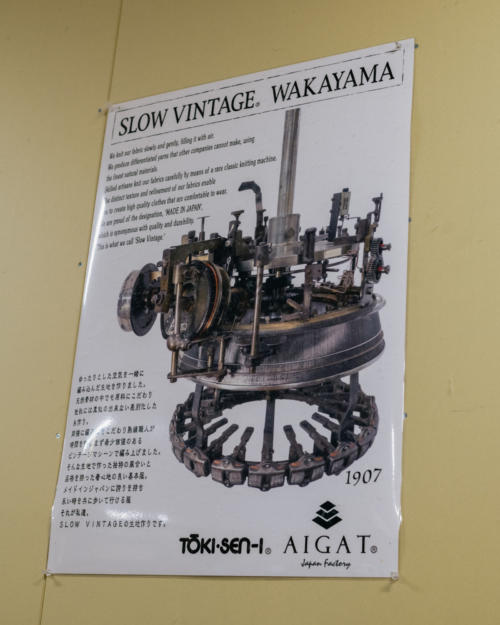
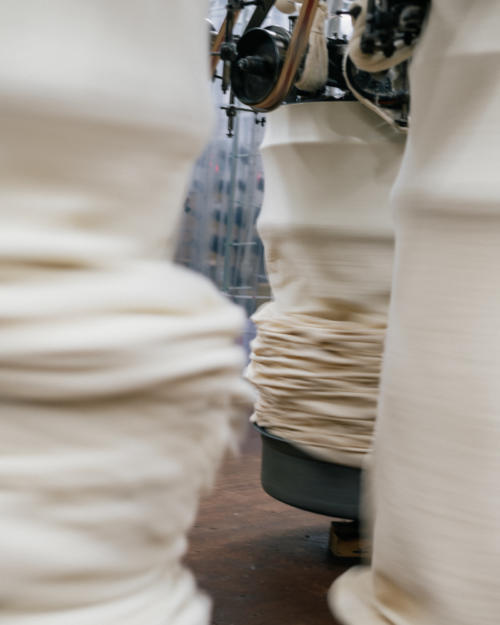
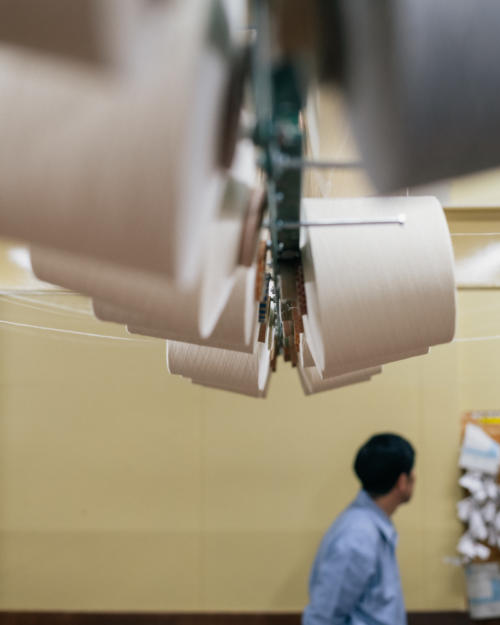


























I enjoy these factory visits Simon. It’s both interesting and useful to understand how the fabric of our garments is made.
Nice to hear, thanks Noel. I find it particularly inspiring when it’s with slightly cheaper products like this, as you really do appreciate that piece in your wardrobe in a way you wouldn’t necessarily have done before
Very enjoyable to read, especially since I was in Wakayma a few years ago and stayed there on Mount Koyasan. I can picture the area well, the densely forested hills/mountains with the very tall trees, sprinkled with Shinto shrines and Buddhist monasteries.
One question about this, Simon: Is the quality of Merz b. Schwanen the same as the top Japanese spinning mills? In Austria, Merz b. Schwanen can be obtained comparatively reasonably, but more importantly the shape of the clothes usually fits me better.
I wouldn’t say it’s quite at the same level, in my experience – dedicated article on that here
“The problems are the same, it turns out, whether you’re making sweaters in Scotland, shoes in England or French terry in the hills of Japan. The demand for quality clothing is shrinking, and no one is making the machines that make the fabric that makes the clothes.”
My guess is that rising prices are a key factor in demand shrinking. How many people can afford to pay £150-£180 for a Real McCoy’s loopwheel sweatshirt? Or over £500 for a pair of medium quality shoes made in Northampton? Not many in these times of rising interest rates, huge fuel costs and high inflation. Their priority is to pay the higher mortgage, big bills and rising taxes.
The prices of quality clothing rose substantially even before inflation let rip over the last 18 months. Established brands were gobbled up by hedge funds and conglomerates who just wanted to make a fast buck. Greedy owners have hiked prices and alienated loyal customers. Several have already gone bust and others have closed stores, even in big cities like London. It’s no surprise that demand is shrinking. The real surprise is that the industry still has not learned lessons from its mistakes.
I’m sure the recent economic decline is an issue Gary, but the decline in demand has been going on for much longer, 2-3 decades. It’s particularly an issue in areas where there used to be a much bigger support network around an industry – schools to train people, engineers to fix machinery.
And your last comments about greedy owners hiking prices are very presumptive – if you have some actual examples where you know the motivations of people behind brands, please share them. Otherwise try not to make such generalisations without the information.
Church’s shoes is a prime example. New owners and a near doubling in price. By all accounts a reduction in quality too. They’ve pivoted to the “high fashion” market just like Burberry, who now compete with brands like Gucci and Balenciaga.
Other British heritage brands like Aquascutum are on life support, possible due to a failure to modernise, but definitely with a reduction in quality of product.
Still-popular brands like Belstaff have simply reduced the quality of their product.
Well, I guess two points Ray. One is that you don’t know the motivations for any of these actions, and I was pushing back against using words like greed with no evidence.
Second is that Church’s is more an example of a manufacturer being brought into a designer group, and being given the same fixed costs of design, marketing and advertising. The prices are similar to those other designer brands, and the English-made shoes were largely better quality than them. As we talk about regularly on PS, what you get with a designer brand is much more paying for different things (like marketing) rather than much bigger margins. If the companies are listed, the margins are public.
What I find traditional companies find hard to get right, is striking a sensible balance between these two. A lot of them fail because they don’t invest a little, sensibly, in design and marketing. They tend to either rigidly stay how they are, or flip entirely, and reduce the product quality as well as the image.
Something about this comment did strike a nerve with me. Primarily, (i) Church’s shoes and (ii) rising costs. I wouldn’t call Church’s greedy but as the original string in this comment did mention rising costs, I thought I would mention that I purchased a pair of Mirfield trainers in white c.2017 for £250. They were eventually replaced by the model now known as Boland. Current price of the Boland, £830 in the white. Neither trainer can be resoled to the best of my knowledge.
I know that Church’s have been bought out by a designer brand but quite frankly, most consumers will see the pounds signs first. I totally appreciate that there have been substantial price rises in the 6 years. Once I find something I like, there is good chance I will make a repeat purchase. Unfortunately, I will not be returning for a pair of Boland’s.
Yes, that is the big point I think most designer menswear brands miss – that the real long-term money is with the slightly older customer, who is a creature of habit and will buy the same thing again and again. Unfortunately they usually have quite short-term visions (sometimes for reasons of investors or being listed, but that’s a separate topic)
It is quite a different league, but this kind of problem is everywhere. I am a frequent Adidas Stan Smith buyer, but it is getting more and more expensive despite being produced in polyester “vegan leather” recently. I was able to find a leather black one from some retro edition to replace my last ones, but it is getting harder and harder and I am not willing to put so much effort into a pair of sneakers anymore. I always valued their clean and simple style along with some kind of “heritage”, but overall value is not there anymore.
Just to separate those two, Ondrej, prices are going up everywhere as a result of Covid, Ukraine and other factors at every point in the supply chain. Unless they’re more than doubling in a few years, like Church’s, I’d imagine that’s not a strategic decision by the company, just a necessity.
On the polyester product, I assume that could be an issue with supply chains or a desire to avoid leather, but it isn’t necessarily connected to prices.
Maybe, however they also created a “premium” Lux version of this shoe, which means it is a leather shoe with additional price hike.
Ah, yes that is kind of hiding a price rise then
Isn’t it sad that the market for quality sweatshirts, Northampton bench grade (is that the correct term?) shoes etc shrinks, whilst legions of people spend a fortune on cheaply made branded sportswear and trainers… I fully admit to buying some specific labels, like Stone Island, that fit this category. I guess we can only hope a few of the youngsters buying the over hyped stuff gravitate to better made things.
Very true. I think things are swinging in that direction – certainly the next generation is going away from mass consumption (see pre-owned rise) and towards less branded styles, but it’s they could easily see all shops in, for example, Mayfair, as the same. That’s where information helps
Interesting points raised here.
Church went into a conglomerate and I agree their quality declined and their prices rose. Crockett remain a family business, whose quality has remained constant and whose prices have not risen anything like as steeply.
And look what happened to Gieves.
“Greed” tends to capture the thrust of the PE model quite nicely.
I think it can be a little subtler than that. I’m playing devil’s advocate a little here, because I broadly agree with the sentiment here expressed by everyone, but I do think it’s worth not dismissing it as a simple issue. Church didn’t take PE money – and often the conglomerates can take rather longer-term views than PE, which will have to maximise its returns in a few years.
Then there’s companies (eg Hermes) which are at least partly publicly floated. They are under a fiduciary duty, a legal responsibility to their shareholders when it comes to profits. That takes away more control than most people realise – because they are wholly or publicly owned by someone else. That’s one reason Hermes prices have gone up so much in recent years. In theory privately held conglomerates are in a better position than this and can make their own decisions.
Then there’s the investment of our pensions by pension funds in companies – often in similar ones to those described as greedy. We want our pensions to return as much as we they can, but are we greedy for wanting that? Then there are the legal requirements landlords sometimes have as a result of their funding from banks.
If I have a point, it’s just that things are a lot more complicated, and understanding or solving these issues requires understanding a lot of different drivers.
I can only agree with Simon: when one dives a bit deeper in any given issue, it always becomes more complicated than initially taken for granted.
That being said, I still regret the ‘demise’ (as I see it) of Church.
Simon I’m not disagreeing with you, but your explanations are a bit generalised.
Businesses buy other businesses for one main reason, which is that they think they can run it better than it is being run currently.
”Better” can take a myriad of forms, but there is something at the root of the matter (brand, expertise etc) which they believe they can capitalise on. All of this is done with the aim of increasing profit.
So buying synergies, consolidating management, expansion, cost cutting, price increases, brand extension etc etc all work towards this goal.
Prada didn’t buy Churchs because they thought is was cute.
Hey Hugh,
Very true, and the vast majority of the time you’re right. I’d only add that now and again the conglomerates do sometimes buy small makers in order to save them and keep them going. The Chanel group in particular. And sometimes they buy them (particularly in recent years) to secure supply. Just little exceptions
Simon I think you missed a post from me just here.
I made the comparison between how Church and Crockett had evolved since the former was acquired.
I also said “greed” sums up the PE model rather nicely.
And look at what happened to Gieves. Acquired by a HK based conglomerate, which got overwhelmed by its debt and went pop last year.
The Gieves brand is now owned by the same stable as JD Sports.
Hi Jane,
I was replying to you, though I can see how it might not have seemed that way! It was partly about that greed point – is it greedy to want your pension to grow as much as possible? Most of the time, applying these kinds of emotions to companies is not that useful.
Crockett hasn’t really changed/evolved, it’s just that Church’s has become a different type of company, as I mentioned.
Gieves is a horror story, I completely agree, though I’m not sure that shows anything about greed or finance. It was just not that well run and never had a clear, long-term idea of what it wanted to be. Many traditional companies have gone through this, giving one plan about two years to come good, rather than the 10 it needs.
I think you missed my point about Gieves. They may have been poorly run, but that is not what sealed their fate.
They were acquired some years ago by Trinity. Trinity acquired a lot of “brands”, over extended and failed. So Gieves went with it.
Gieves was “rescued” by Mike Ashley. Let’s see what happens now.
I don’t think you actually know that though, do you? Gieves has been struggling for years and years. They may have gone bankrupt if not acquired by Trinity. if Gieves had done better under Trinity, someone else might have bought it and it would have a good life now. I think it’s dangerous to assume anything about that kind of situation if you don’t know it from the outside – what I see people comment on on forums etc is rarely how I actually see the companies I know from the inside.
Ah that’s a shame Jane, but thank you.
About traditional companies failing. One example comes to mind and thats Lockie who have managed to keep quality high and prices reasonable. If I can ask why do you think they have managed to survive and keep untainted image. What is it that they did right, unlike many of their peers. Is it the private and designer label contracts or the loyal traditional client base or something else?
Well, Lockie are mostly not a retailer, more a maker. I think there’s an interesting subject there in when those two merge to different extents, but the way you survive as a maker is by making solid consistent products. It’s the boring stuff like hiring well, managing people, doing good customer communications. You’d be amazed how many suppliers we work or have worked with that fail to do this from day one.
I don’t intend to prolong the conversation on greed but I wanted to share some observations and thoughts. I don’t think greed is a fair characterization here for a number of reason, many have been mentioned here but additionally I’d caution folks from moralizing cost instead of behaviour. Cost in and of itself is not an indicator of greed. Low cost, high volume clothes sales can result in much more harmful working conditions, poorer environmental standards, erosion of craft, and higher margins. When moralizing, I tend to think more about behaviour, actions, and practices than consumer price.
Simon, lovely article. The first third, admittedly made me somewhat melancholy for the loss of craft. It reminded me that Turner painting where the ship is bein hauled away by a steamship for scrap. I’m glad to see folks still working to keep these things alive. All the more reason to be mindful to protect it where possible.
Hi Simon, I agree that the price topic is a tricky one. Especially with smaller and quality or craft-oriented companies, which most likely do anything they can to keep their prices as low as possible, with much lower margins. However, I have been surprised recenty at the price hikes of some of them, Drake’s being a prime example – even though I still like what they do, and I do think they have been important in the quality menswear resurrection. I have not calculated a percentage but somes prices seem now quite unreasonable.
You’re right Gab, though I’d like to avoid having the Drake’s conversation again!
Combined with rising prices and stagnant wages I think unfortunately a lot of people simply either don’t appreciate or understand quality. I, for one, did not until I did a lot of reading of this blog and others who were able to give more of an insight into things like why loopwheeled French terry is special. When I was buying my first pair of black Oxfords one of my friends balked at the price and asked why I didn’t buy cheaper ones still marketed as leather. Many of my friends even if they can afford nicer than Primark or Tesco wonder what the advantage in buying a slightly nicer item is, especially if they can get more, unless an item has failed them in a particular way.
If I may ask Aaron, what convinced you, and what do you think is the best way to convince your friends?
I think this is indeed the main point: society as a whole has been trained to accept simpler, more utilitarian, less refined and lower quality clothes for decades as time-saving and cost-cutting innovations drove prices down and down while replacing long, expensive processes with much quicker, cheaper, often more automated alternatives that are “good enough”, but not quite like the expensive original (e.g. synthetics instead of wool and leather, suit fusing, sinker machines instead of loopwheel, etc.).
And now most people never even learned to recognize quality because they’ve never been told about it, nor have they ever experienced it.
To answer your question to Aaron, since I agree with him:
I was in the same position in my early 20s, I knew nothing of quality and didn’t even have any interest in clothing. Until almost randomly, at some point, I decided my wardrobe didn’t really feel like me anymore, and so – being a very methodical person – I started reading a lot about clothes to figure out what I actually wanted instead. And that opened my eyes to quality, design and possibly even some concepts of what is generally considered esthetically pleasing and why.
Only then I finally decided to try the next tier up in cost, still being very skeptical about the seemingly disproportionate cost (compared to fast-fashion, though I didn’t buy it in a fast-fashion way, i.e. very seldom at all and very much ignoring trends) and whether it was all worth it. And only then, after trying and wearing those, I started to fully appreciate them, and it only lead up.
But many other people I know never had such a realization, thus never took any interest in clothing, and as such never tried to read or talk about it, never learned about it and never changed their evaluation of cost and quality as a result.
I wonder whether the current resurgence of second-hand might make a difference. I know most people that are into it are more about either the sustainability aspect, or they just like vintage looks (almost as a form of novelty found in the past), rather than do it to acquire quality clothes for much cheaper (which is what has motivated me in the past years instead). But on the other hand, even if that isn’t the purpose that drives those customers, it might still reintroduce more quality clothes into circulation and those people who wouldn’t have otherwise might at least get to experience that.
For me personally it was as a result of deciding I wanted to try and dress better than I had been, and I had an understanding paying more for shoes generally meant better quality but to be honest all the shops I knew were high street ones – so instead of £40 shoes from Clarks it was £70. Probably no real quality increase. It wasn’t until after I graduated and had a lot of free time whilst jobhunting that I decided to start really looking into things with various websites and blogs and reading advice on what made certain things higher quality – particularly early on through Gentleman’s Gazette, PutThisOn, Die Workwear! and eventually PS. I generally have an interest in materials anyway so that helped push me forward with research and I’m generally curious and wanted to know why all the £100-150 ties cost that versus the £50 silk ties, for example. I’m not sure if I had as much free time if I’d have been able to pursue it to such a degree, especially since whilst there was plenty of overlap there was often a unique point of knowledge on various sites for the same item. I also had a lot of time to window shop different brands to get a baseline of what prices to expect for certain quality.
Honestly, I’m not sure. I try different approaches for different ones. The more ecologically minded ones I try to talk about microplastics to try and get them to at least buy items such as sweats out of cotton rather than polyester, but it’s not always easy when a lot of them have little disposable income and can’t afford the really nice things and there’s a bit of a dearth of 100% cotton sweats available in the cheaper price ranges. Other friends I might try and emphasise things being made England with better paid makers and how we should support that and support better working conditions. But a lot simply don’t care so long as the cheaper item has a somewhat similar look at first, a lot of them don’t seem as interested in how things age or having a core wardrobe. Hell, most of them won’t even listen to me on simple bits of style such as keeping lower suit button undone or not having matching tie and pocket square even when they ask for advice.
Also, apology for the wall of text. I actually had split it into paragraphs but the website condensed it all (i.e. skipping the white lines).
I guess I should have double spaced it like this.
Good point And, I’ll see if we can change that
I think this is a very intresting discussion, because so many diffrent topics emerge in it.
First and for me most importantly: people are just not intrested (enough) in long lasting and well made clothing (and other things aswell!). Every single one of my (student) friends says it‘s bonkers to pay 500€ for a pair of shoes. In my mind it‘s not, because I‘m making a informed purchase and will keep them in well shape and maybea own them for the next 20 years (and will look good doing so!). They see the point with longevity, hence why I have convinced them to buy better brands like H&M, but still the very nice stuff is still way too much for them. They just do not see how it could be reasonable to buy something that expensive like a nice raw denim for 300€. Why that is?
I think beeing not as well informed is only part of the reason. No matter how well the explanation, no matter how many positive aspects I point out: there is still inhibiton to pay more than what‘s thought to be a good price for a pair of jeans (e.g. Levi‘s for 100€). As a brand I may give my (potential) costumers more insights and information to why it‘s a good choice to buy the product and what benefits it has, but honestly I doubt it would convince that many people.
And this (in my mind) has to do with factor two: people just like to consume, rather than wear. Not many people have „found“ or „settled“ theire style enough to make a choice for years to come. They want to pursue trends, not pursue a personal aesthetic. It is hard to justify a high price for a pair of shoes, if you‘re not certain you will still like them in 5 to 10 years!
Third, some people want to be seen as wealthy and like to wear brands to the outside, show what they have. Big part of this is why certain Luxury Brands work that well. They are a status symbol and bought for that. Sometimes it is quite funny what people think some clothes cost if there is no brand name on it or they are missing knowledge of what is the price for good quality. Most of the time people guess half of the real retail price for some of my nicest and most beloved clothing. One friend said my RRL Deck Jacket looks like 50€ thrifted in Berlin. And it (sadly) has no patina whatsoever right now (but I‘m working on it!).
Lastly I want to comment on two brands mentioned above.
I have no experience with new church‘s Shoes, but I have seen the black calf brouges my brother bought from them 20 years ago. They‘re superb, made his C&J and Alden look like Boggi Shoes (I am exaggerating)!!! At least back then they were amazing. Theire prices today are quite high, but if they meet the same quality I would probably say they are kinda worth it (tho I cannot compare to e.g. Edward Green or Gaziano and Girling).
And about Stone Island, well, I have seen theire decline the past years with a wet eye. I love the brand and the story behind it, aswell as theire funky innovative stuff. But they got quite expensive over the past years and the introduced a lot of clothing, that is kinda merchandise. Value is not that good with a printed Tee for 150€. But the outerwear and knitwear is still great and unique! Both expensive, but when I was searching for a good down filled Winter Jacket it felt like there was no way around a Stone Island one. Other established makers of such parkas and down fillled jackets could not compete in my opinion. Sure tho, I leave the compass at home:)
Just my 50 cents, ha!
Best regards from Germany
Great article Simon. I have bought a number of sweatshirts from The Real McCoys and although they are expensive they last, are great to wear, and get softer after every wash.
Hi Simon, very interesting article. I always enjoy these more technical pieces. I think you mentioned a while back about a visit to The Real McCoys vintage archive, are you planning to cover that? I could be mistaken though.
p.s Evangelise as much as you like in my opinion.
Thanks Stephen. And yes, that’s coming, fairly soon
Maybe a slight tangent but do you if The Real McCoys are planning to open another store in London again?
They do hope too, but it’s not happening soon unfortunately
It will be great if/when they do. It was a very enjoyable shopping experience when I visited to purchase a parka. I have purchased from them online. The service and delivery was excellent, for me however I much pref the in store experience.
Couldn’t agree more. The only upside is I spend less than when I was in there every week!
There is that :-)!
Thanks Simon, great shame they closed down so hope to see them back soon
Simon,
Outside of the shopping guide, do you have a list of favorite or recommended factory tours?
Good question. No I don’t I’m afraid Caleb, as I’ve never actually done one as a non-professional. Maybe other readers can chip in with ones they’ve done
If it’s of any consequence, I have done Morgan, Aston Martin and Bentley tours. Parallels can be drawn with bespoke tailoring; a lot of handwork!
More heritage than modern industry but might be of interest to those needing a fix of industrial history.
Not factories as such but have spinning or weaving.
Trefriw Woollen Mills Ltd near Conway is a site that has tours and a decent shop. Good for lengths of tweed.
Macclesfield Heritage Silk Mill – good for ties (and my mum is a volunteer there).
Helmshore Mills near Blackburn.
Queen Street Mill Burnley.
Photo is Queen St.
Hi Simon,
Similar to others I always find these articles interesting.
One thing I do wonder at though is how practical it would be to have a more open door policy to the process. For example, I’ve inquired in the past about whether one can visit raw denim manufacturers in Japan and the answer is always no – unless you’re looking to buy/existing client.
I understand why this may be but I wonder if the industry is short-changing itself on a market opportunity. We all know what suckers tourists are for a story especially one about heritage.
I think the problem is it can be quite disruptive and take up a lot of time. It’s much more efficient to let journalists visit, as here, and for them to then talk about it to thousands of people, than to do lots of tours
I don’t disagree but I wonder if there will ever be a step change to where we’re more open door on factory/manufacturing processes as it could significantly influence how people view the cost of the output. Maybe before this happens we will see more targeted advertising around this? Again all just speculation but you’d think something has to change because with all due respect I don’t think the journalists are speaking to any of the uninitiated.
I’m not sure that’s true, as you did get quite a bit of this kind of coverage when craft and heritage started being trendy about 10 years ago now. I think if people are interested generally then that kind of mainstream coverage does come back
If you’re interested to see how a cotton mill works, I highly recommend the Queen Street Mill Museum in Burnley. It’s a museum rather than a commercial mill, but it’s the last surviving 19th century steam powered mill in the world.
Every single time I see something like this or read about it, it makes me want to buy something just because it‘s such a beautiful craft. Same goes with your Visit at Hermes or a old Menswear Article I read about Tod‘s and Kiton. Thank you very much for these insights! Makes me appreciate my Merz B Schwanen Loopwheel T-Shirt even more
Lovely to hear Amon
There’ve been a few references to Merz and I thought it’d be worth making a couple of observations. Their sizing seems to be inconsistent. And some of their stock now seems to made in Portugal and without the same finesse. Which is a shame as I rather like the brand.
Thanks John. What is now made in Portugal- is it particular lines?
Hi Simon, I noticed the Portugal manufacturing tag on some of their tees being sold in Australia. Though the kicker was the appearance of a lower quality product (I have nothing against Portugal manufacturing per se).
Absolutely, I was just interested to see whether it was any of the traditionally loopwheel stuff. I wouldn’t necessarily be expecting them to use loopwheel on the T-shirts they do
Thanks Simon, beautiful little slice of coverage this one. Busy week so only getting the chance to catch up.
Are we saying then, that as the years pass by, it’s going to be increasingly difficult (and costly) to get our hands on loopwheel (and Sinker woven)? Can we then expand that to high quality footwear, boots, denim, leather jackets etc.? I suppose tailoring and it’s reliance on mills falls into that category as well.
I try to contextualise sometimes just how much of a minority we’re in, in comparison that is to what is seemingly the majority of people who see little value in clothes beyond a few months/ a season. Are we 10% of the population? 5%?? I know for a fact you will perpetually be trying to quantify this question yourself, knowing that percentage is going one way and it isn’t up.
I’m really not sure to be honest CK. I’ve never looked into it, and I wouldn’t say it’s necessarily always going down – the resurgence of interest in craft and authenticity 10 years ago I’m sure made it go up. But then it’s probably started to slide again now
Thanks Simon. Is there a possibility I’ve got it wrong? I live in a small, quiet corner of the UK, so my exposure is really entirely online and it’s hard to tell from the people around me, beyond seeing the odd person in a nice pair of denim or quality boots/shoes etc.
I love to think it’s actually the opposite – more and more people adopting the buy less/better mentality, particularly as our awareness expands regarding the impact on the planet etc. and simply just appreciating better made things.
I also have to remind myself, something I remember you mentioning a while back, most people only have so much money to allocate, often cars, tech, holidays etc. can take priority.
You will have a much deeper perspective on this, both being in London along with your visits to crafts people, mills, factories etc.
True, though even then I find it hard to tell CK. I think you need some more general data really, from shops or broader surveys
Dear Simon,
I hope this comment finds you well. We absolutely love your content and the manner in which you present the information. Your insight on the subject matter truly shines through your writing, and I found myself deeply engaged with the content shared in this article.
I am particularly interested in discussing some aspects of your article further. I have been on a journey of attempting to locate and work with a loop wheel knitting factory to work with in our quest to create the highest quality ultimate Pima t-shirt that we can make as a new men’s lifestyle brand. We look to provide great value of offerings to our prospective customer and this goal has led us to loop wheel knitting fabric for our opening to the marketplace.
Would you be willing to share the factory contact details in Wakayama?
Thank you for your time and consideration. I look forward to the possibility of connecting with you and further exploring the topics you covered in your blog post.
Best regards,
Omar
Hi Omar,
Lovely to hear from you. I’m afraid Aigat didn’t want to be contacted and said they had too much business – Real McCoy’s struggle to get enough made themselves. Sorry I can’t help.
S